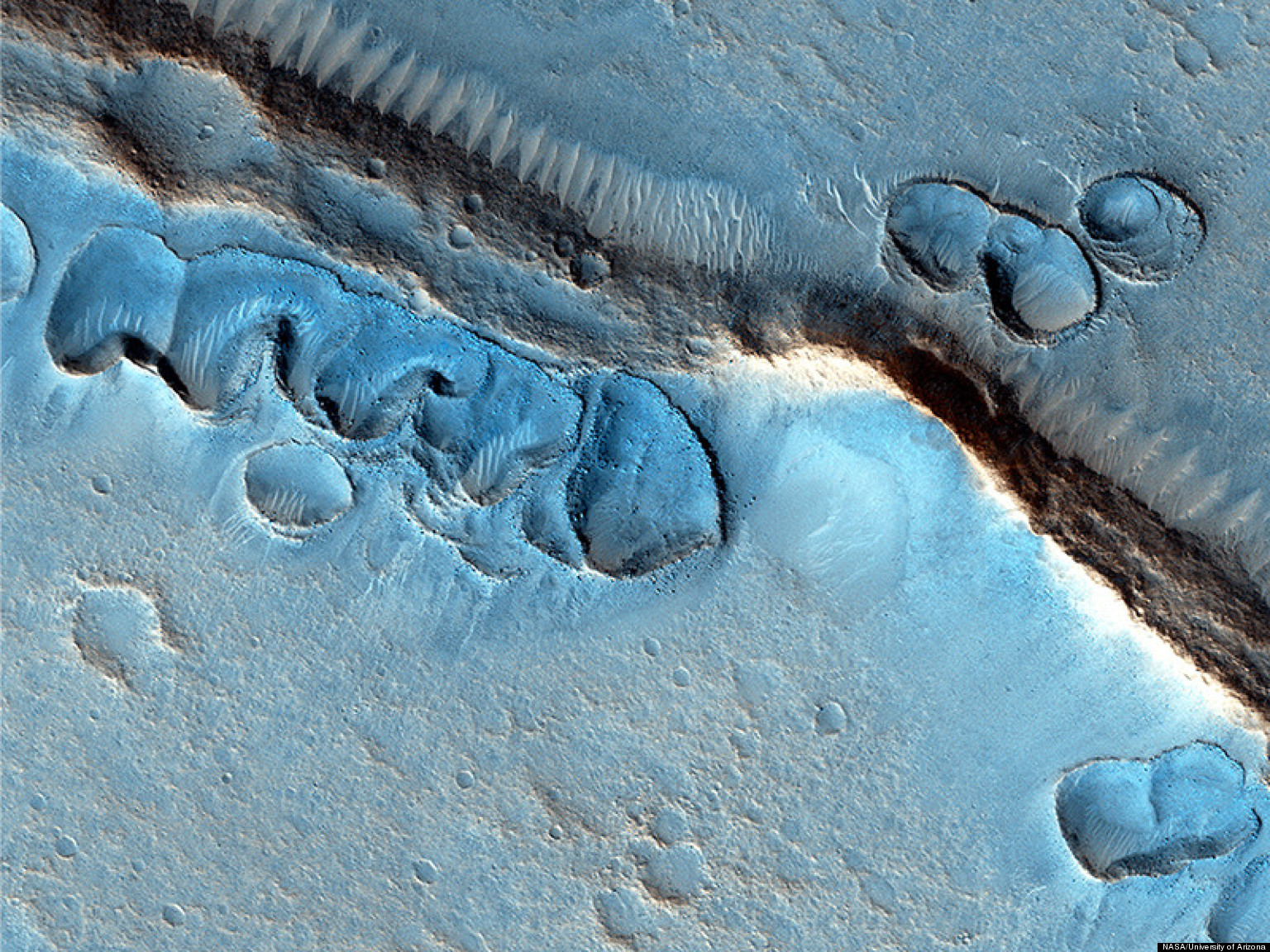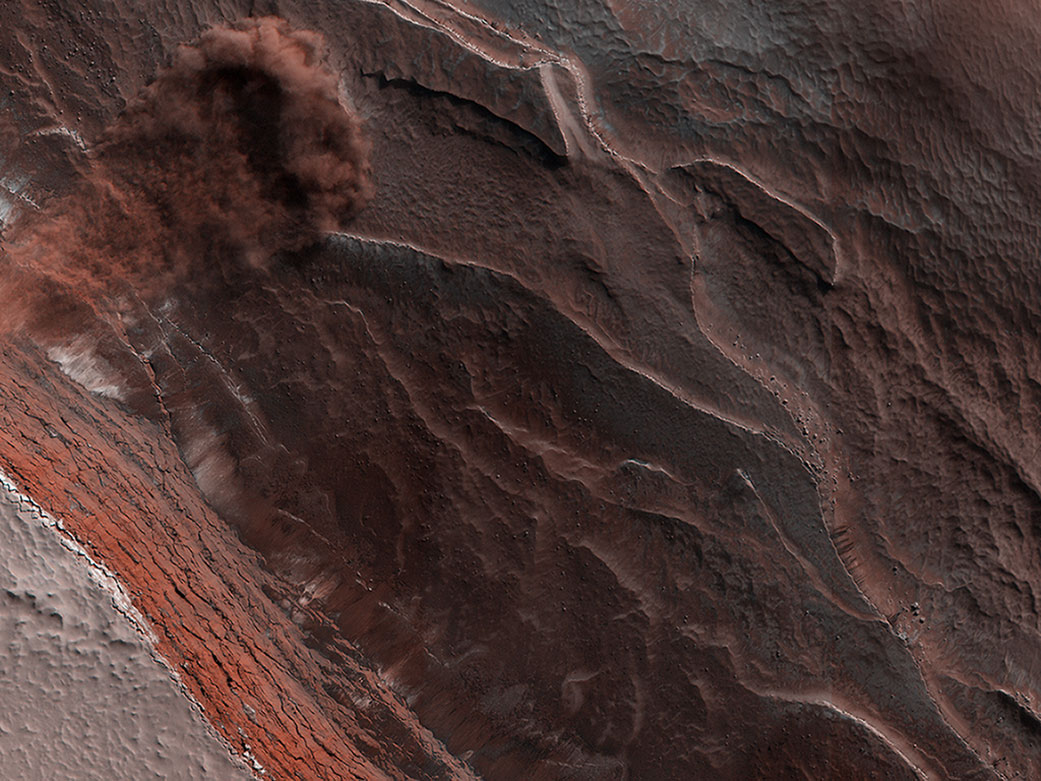HiRISE Captured Perseverance During Descent to Mars February 19, 2021 The descent stage holding NASA’s Perseverance rover can be seen falling through the Martian atmosphere, its parachute trailing behind, in this image taken on Feb. 18, 2021, by the High Resolution Imaging Experiment (HiRISE) camera aboard the Mars Reconnaissance Orbiter. HiRISE (High Resolution Imaging Science Experiment) is the most powerful camera ever sent to another planet, one of six instruments onboard the Mars Reconnaissance Orbiter. We launched in 2005, arrived at Mars in 2006 and have been imaging ever since. Mars has some fascinating a beautiful craters, but are all craters the same, or are there aspects that make each one unique? NASA's MRO has a closer look wit. HiRISE: 45,000 Mars Orbits and Counting Ten years ago on March 24, the UA-built camera began taking the most detailed images of the Martian surface to date. Since then, the camera has become the world's eye on Mars, bringing us detailed vistas of landscapes ranging from strangely alien to earthly familiar.
The High Resolution Imaging Experiment is known as HIRISE. The big and powerful HIRISE camera takes pictures that cover vast areas of Martian terrain while being able to see features as small as a kitchen table.
Tech Specs
| Main Job | To study active surface processes and landscape evolution. |
| Location | On the Nadir side of the spacecraft looking down at Mars. |
| Mass | ~143 pounds (65 kg), including thermal control system, cables, etc |
| Power | 60 Watts |
| Size | ~5.2 feet (1.6 meters) long by ~2.9 feet (0.9 meter) diameter |
| Data Return | Can acquire images containing up to 28 Gb (gigabits) of data in as little as 6 seconds |
| Color Quality | 14 electronic detectors, each covered by a filter in one of three wavelength bands: 400 to 600 nanometers (blue-green), 550 to 850 nanometers (red), or 800 to 1000 nanometers (near infrared), producing color images in the central portion of the field of view. |
| Image Size | Pixel size in images taken from an altitude of 186 miles (300 kilometers) is about 12 inches (30 centimeters) across (about basketball-size). Overall image size is a swath width of 3.7 miles (6 kilometers) by a programmable image length of up to 37 miles (60 kilometers). |
| Image Resolution | Smallest resolvable features in the images are about 3 feet (~1 meter) across (features as small as a kitchen table in images covering swaths of Mars' surface 3.7 miles, or 6 km wide). |
| Focal Length | ~40 feet (12 meters) |
| Focal Ratio and Field of View | f/24, yielding an IFOV of 1 x 1 μrad and a telescope FOV of 1.14 degrees x 0.18 degrees |

High Resolution Imaging Science Experiment
HiRISE (High Resolution Imaging Science Experiment) has photographed hundreds of targeted swaths of Mars' surface in unprecedented detail.
Hirise Camera Mars
The camera operates in visible wavelengths, the same as human eyes, but with a telescopic lens that produces images at resolutions never before seen in planetary exploration missions. These high-resolution images enable scientists to distinguish 1-meter-size (about 3-foot-size) objects on Mars and to study the morphology (surface structure) in a much more comprehensive manner than ever before.
HiRISE also makes observations at near-infrared wavelengths to obtain information on the mineral groups present. From an altitude that varies from 200 to 400 kilometers (about 125 to 250 miles) above Mars, HiRISE acquires surface images containing individual, basketball-size (30 to 60 centimeters, or 1 to 2 feet wide) pixel elements, allowing surface features 4 to 8 feet across to be resolved. These new, high-resolution images are providing unprecedented views of layered materials, gullies, channels, and other science targets, in addition to characterizing possible future landing sites.
Areas for close-up HiRISE imaging are selected on the basis of data returned from Mars Global Surveyor, Mars Odyssey, and regional surveys conducted by the Mars Reconnaissance Orbiter's own instruments.

The Principal Investigator (lead scientist) for HiRISE is Alfred McEwen from the Lunar and Planetary Laboratory at the University of Arizona.
Visit the instrument site: HiRISE Instrument Site

Mars
Hirise Mars Photos
The Pristine Beauty of the Red Planet
Hirise Mars Images

Nasa Hirise
Mars enthusiasts will appreciate these perfect snapshots of our current understanding of Mars, with soon-to-be classic pictures that have come to define our vision of the Red Planet. These images and their interpretations will be held as a yardstick for future exploration as we learn more about the surface and geologic processes of the fourth planet from the Sun.
With tantalizing and artistic glimpses at actively eroding slopes, impact craters, strange polar landscapes, avalanches, and even spectacular descent pictures of probes like the Phoenix Lander and the Mars Science Laboratory, we see what researchers are seeing.
Through vivid and beautiful images, this book underscores the need for such a camera on future orbiters, especially as more landing missions are planned. Mars: The Pristine Beauty of the Red Planet provides a stunning keepsake of one of humanity’s greatest accomplishments in space travel.
Mars Hirise Orbiter
“Splendidly illustrated. . . . Every picture puzzles and delights.”—Choice
“While the book might at first be seen as a coffee-table art form, it is actually more of a gateway to a database of scientific research. A slab of publishing excellence.”—E&T Magazine
“Mars is one of the best places to search for signs of life beyond Earth, and it is a world that humans may one day call home. It is also a world of staggering beauty. The HiRISE camera on NASA’s Mars Reconnaissance Orbiter has revealed the stark and sometimes bizarre landscapes of Mars in spectacular high resolution and vivid color for the first time. In Mars: The Pristine Beauty of the Red Planet, the best of those images are gathered together, providing the most dramatic views of the red planet ever seen. It’s a book that belongs on the shelves of anyone who cares about Mars’s ancient past, or about its role in humanity’s future.”—Steve Squyres, Principal Investigator, Mars Exploration Rovers

Comments are closed.